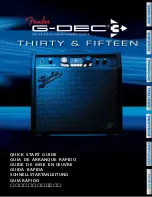
REAR PANEL
Power Entry Module
The power entry module is used to fuse the AC line voltage input, select
the line voltage, and block high frequency noise from entering or exiting
the instrument. Refer to the first page of this manual for instructions on
selecting the correct line voltage and fuse.
IEEE-488 Connector
The 24 pin IEEE-488 connector allows a computer to control the SR830
via the IEEE-488 (GPIB) instrument bus. The address of the instrument
is set with the [Setup] key.
RS232 Connector
The RS232 interface connector is configured as a DCE (transmit on pin
3, receive on pin 2). The baud rate and parity are programmed with the
[Setup] key. To connect the SR830 to a PC serial adapter, which is usu-
ally a DTE, use a straight thru serial cable.
AUX IN 1-4 (A/D Inputs)
These are auxiliary analog inputs which can be digitized by the SR830.
The range is -10.5V to +10.5V and the resolution is 16 bits (1/3 mV). The
input impedance is 1 M
Ω
.
These inputs may be displayed on the CH1 and CH2 displays. These
inputs allow signals other than the lock-in outputs to be acquired (and
stored). Furthermore, ratio quantities such as X/Aux1 may be displayed
(and stored).
AUX OUT 1-4 (D/A Outputs)
These are auxiliary analog outputs. The range is -10.5V to +10.5V and
the resolution is 1 mV. The output impedance is <1
Ω
and the output cur-
rent is limited to 10 mA.
These outputs may be programmed from the front panel ([Aux Out])or via
the computer interfaces.
X and Y
The X and Y lock-in outputs are always available at these connectors.
The bandwidth of these outputs is 100 kHz. A full scale input signal will
generate ±10V at these outputs. The output impedance is <1
Ω
and the
output current is limited to 10 mA.
4-27
Summary of Contents for SR830
Page 5: ...1 4...
Page 11: ...SR830 DSP Lock In Amplifier 1 10...
Page 13: ...2 2 Getting Started...
Page 17: ...2 6 The Basic Lock in...
Page 23: ...2 12 Outputs Offsets and Expands...
Page 25: ...2 14 Storing and Recalling Setups...
Page 31: ...3 4 SR830 Basics...
Page 33: ...3 6 SR830 Basics...
Page 37: ...3 10 SR830 Basics...
Page 53: ...3 26 SR830 Basics...
Page 74: ......
Page 83: ...4 30 Rear Panel...
Page 107: ...5 24 Remote Programming...
Page 113: ...5 30 Remote Programming...
Page 117: ...5 34 Remote Programming...
Page 121: ...6 4 Performance Tests...
Page 123: ...6 6 Performance Tests...
Page 125: ...6 8 Performance Tests...
Page 129: ...6 12 Performance Tests...
Page 131: ...6 14 Performance Tests...
Page 133: ...6 16 Performance Tests...
Page 139: ...6 22 Performance Tests...
Page 145: ...7 2 Circuit Description...
















































